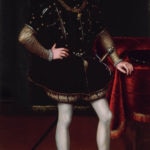When 'dressing Spanish’ was in style
There was a time when fashion was not decided in Paris, Milan or New York. At one point, it was Philip II’s Spain, an empire where the sun never set, who told the world how to dress. As a reflection of the time, art is the perfect guide to learn about fashion in the 16th and 17th Centuries through the BBVA Collection.

Spanish high society imposed a style dominated by decorum and formality. The rigid black garments became a symbol of power and nobility, and European courts and American viceroyalties began “dressing Spanish”.
If black became the symbol of a privileged social class, it was due to the quality of the dye, called “raven’s wing”. It made its way from America, specifically from Mexico and its high cost made this color a luxury that many desired but few could afford. It was Philip II who decreed this austerity by law for moral and economic reasons –a style that lasted until Philip III and Philip IV.

Philip II of Spain, Anonymous (Circle of Alonso Sánchez Coello), ca. 1565 - BBVA Collection
The doublet, a garment that covered from the shoulders to the waist, was worn on top of a shirt, fitted to the body. Thighs were covered by breeches with openings. Stockings were white and covered the entire leg.
During Philip II’s rule shoes were pointed, with large slashes in the arches and two more on the sides. Later on, the tip of the shoe became flatter and laces were added.
White ruff collars stood in contrast to the somber clothes. This garment, made with fine cloth from the Netherlands, was dyed with powder to make it a shade of light blue. Over the years, ruff collars grew in size until the rule of Philip III, when clerical collars were needed to hold them in place. White cuffs matched the ruff.

Philip III of Spain, Juan Pantoja de la Cruz, 1605 - BBVA Collection
The 17th Century: the end of Spain’s hegemony
Throughout the 17th Century, French fashion was replacing Spanish fashion in European courts as a reflection of the changing global political scenario. Black, however, continued dominating in Spain and the Netherlands, where it became a symbol of austerity as a result of the Puritan Revolution.

Portrait of a Gentleman and Portrait of a Lady, Michiel J. van Mierevelt, ca. 1610-1620
Gold motifs on top of black and lace headdresses and cuffs were the hallmark of nobility for both men and women. The fan —a detail in Portrait of a Lady— was not introduced in Holland until the 17th Century and was further proof of a high socioeconomic class.
Philip IV: the culmination of sobriety in Spanish fashion
In 1623, Spain moved away from the canons of French fashion, full of luxury and color, with Philip IV’s pragmatic fashion, which emphasized the sober garments of Spanish nobility.

Young Knight of the Order of Santiago, Anoynmous, ca. 1650 - BBVA Collection
The ostentatious ruff collars from previous periods gave way to a much more austere ruff, made of stiff cardboard covered with a black cloth. A white walloon collar, or a valona, was placed on top. This garment kept the head upright. White stockings were also replaced by black and the breeches with openings were abandoned for tighter, black breeches.

Doña María de Vera y Gasca, Juan Carreño de Miranda, ca. 1670 - BBVA Collection
In the second half of the 17th Century, women begin to notice the growing influence of French fashion with hoop skirts. Although this garment originated in France, it is an evolution of the farthingale that began in Spain, which was also used to make dresses more voluminous.
In the middle of the 17th Century, the doublet’s sleeves opened to reveal the sleeves of the shirt, which tended to be made of lavish fabrics. Women also stopped using headdresses and began to wear their hair down, and longer (even using hairpieces). They parted their hair on the side, with a wave across their foreheads.